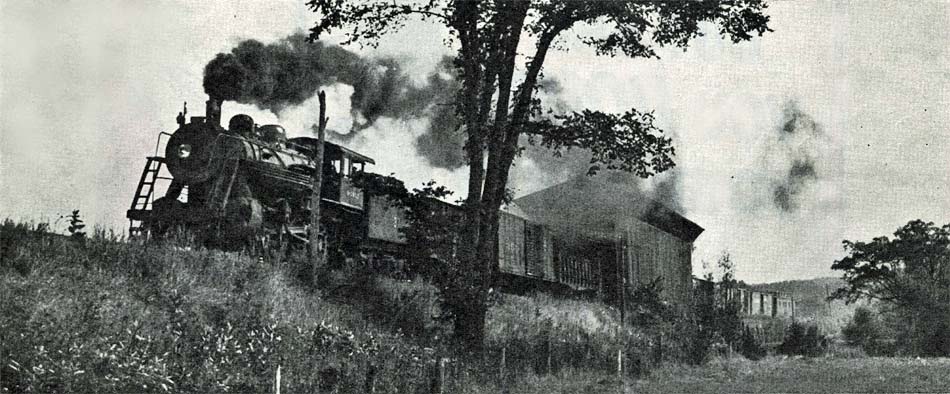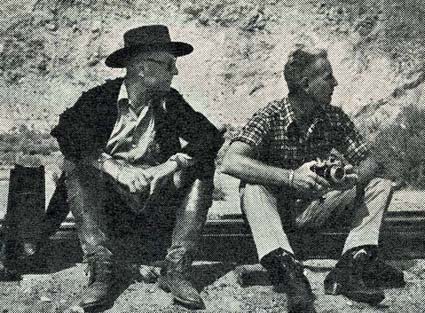
Canadian Pacific Staff Bulletin - September, 1946
the Shortline Way

There are all kinds of railroad fans and historians. There is, for example, one professional biographer
of railroad corporations who on the side collects old time locomotives the way some people collect stamps or
butterflies.
There is another whose passion is for live steam working train models and whose summer estate a few miles
from New York is scarcely distinguishable from a roundhouse and engine shops on a miniature scale. There is a
novelist, who is president of an industrial road in South Carolina and whose pleasure it is to people his board
of directors with characters of national fame.

And there are Lucius Beebe and Charles M. Clegg who collect shortline railroads in the sense that they
have probably ridden on, photographed, and written about more off-the-beaten-track railroads in the United
States than any shortline enthusiasts in the land.
Their latest book, "Mixed Train Daily", a book of shortline railroads, contains more than 300 action photographs taken by the authors along railroad rights of way whose very names are unknown to the vast majority of people in Canada and the U.S.A., but whose freight and passenger business are none the less ponderable items in the national economy.
A century ago all railroads were shortlines in an age when it was necessary to change cars five times on a trip between Boston and New York, but today most of these little pikes have been swallowed up in the big trunk systems so that the Pennsylvania system, for example, is composed of no fewer than 300 once individual roads. There are still, however, more than 500 shortline railroads in business in the United States, most of them possessed of but a few miles of indifferently ballasted track and many of them operating with but a single ancient locomotive of archaic design.
"Many of these shortlines are really living on borrowed time," explains Beebe, whose previous volumes on railroading are regarded as standard works in their field. "Some of those we have ridden and photographed have folded up and disappeared forever even while we were working on this book. We feel that a record of their operations and old time simplicities of railroading is very much an item of Americana. You can imagine how valuable it would be today if the fast action camera had been available to provide a record of the Concord stagecoach days in the far west, or the Mississippi River packets. Even the Amoskeag steam fire engine, once a familiar sight in the every day life of city dwellers is hardly represented at all in the files of the great photographic agencies. Yet the horsedrawn steam fire engine was universal only twenty-five or thirty years ago."
Some of the prize items in Beebe's and Clegg's collection of shortlines are the Mississippi & Alabama Railroad, the last wood burning common carrier in the United States, the Nelson & Albermarle in the Blue Ridge Mountains, the only common carrier to haul mail and passengers behind a saddle tank locomotive, the Virginia & Truckee, "most romantic railroad in the world" which flourished during the days of the Comstock bonanza in the boom towns of Nevada, and they have ridden on and photographed each of the five still surviving narrow gauge railroads, relics of a time during the seventies when the diminutive three foot gauge spanned thousands of miles of the American continent. One of these, the Sumpter Valley in the Blue Mountains of Oregon is being abandoned even as this is written.
Beebe and Clegg are also connoisseurs of romantic railroad names, and have travelled the length and breadth of the United States to ride on the Arcade & Attica in Upper New York State, the Tonopah & Goldfield in the ghost towns of the Nevada desert, the Sylvania Central in Georgia, the Wach Beaumont Trinity & Sabine in East Texas, and "Tweetsie" as the East Tennessee & Western North Carolina Railroad is affectionately known to the mountain folk of the Great Smokies in Tennessee.
When the author and his companion wanted to chronicle the rarest of all shortline collector's items, the Rio Grande Southern, a narrow gauge line in the lonely mountains of southwestern Colorado, the Denver & Rio Grande Western, the parent railroad, provided them with a special train of two narrow gauge business cars dating from the seventies, and they spent three days travelling over the Southern's 162 miles of right of way.
 and is reprinted here with their permission. All photographs,
logos, and trademarks are the property of the Canadian Pacific Railway Company.
and is reprinted here with their permission. All photographs,
logos, and trademarks are the property of the Canadian Pacific Railway Company.